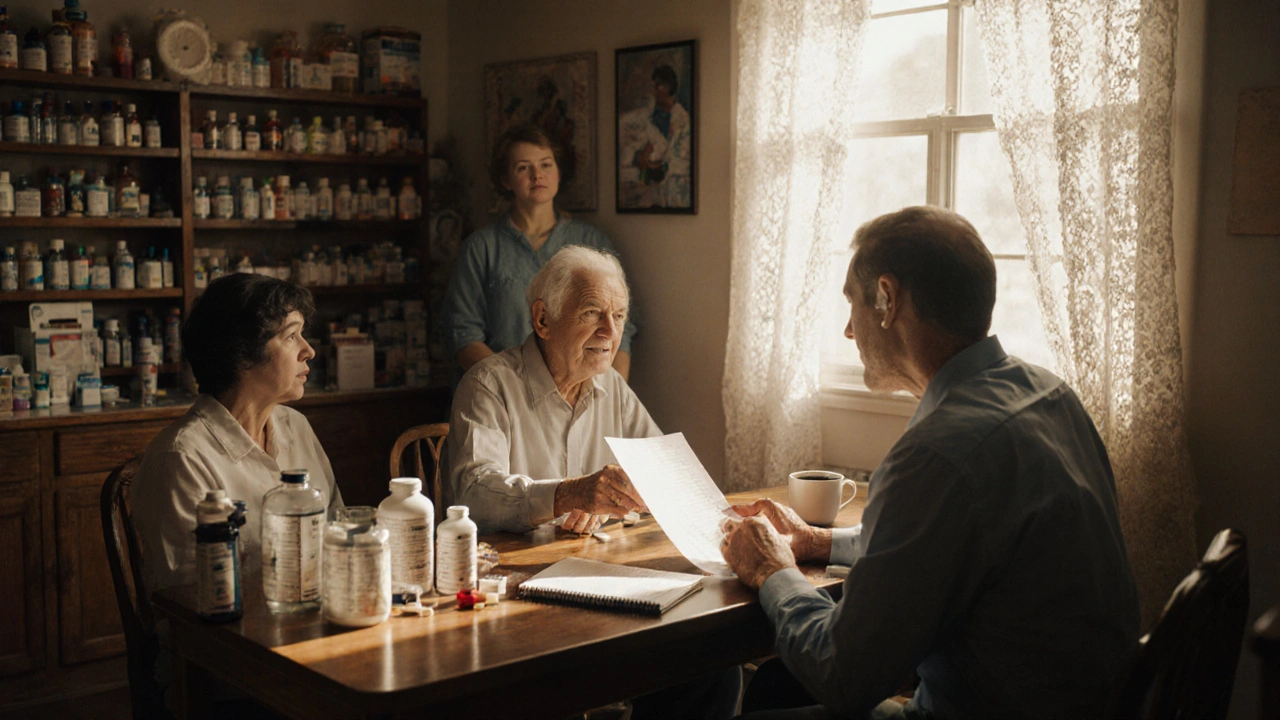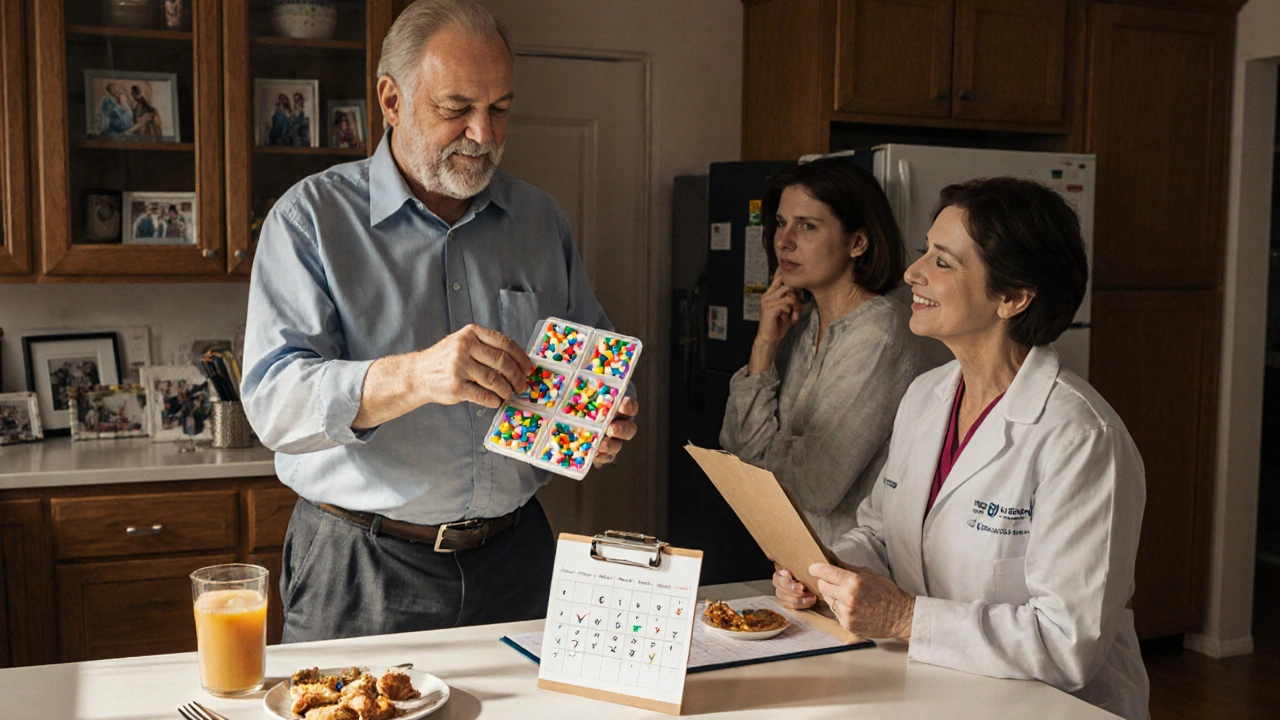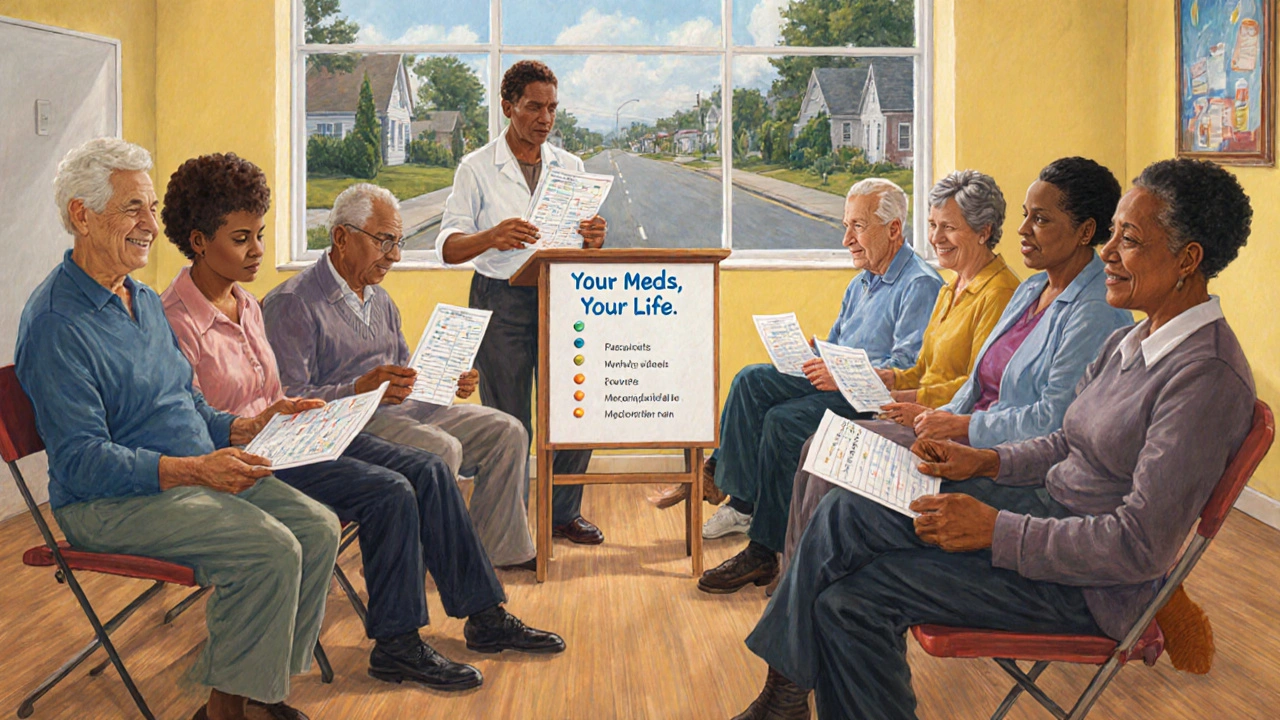Medication Therapy Management Services Explained for Patients
 Nov, 17 2025
Nov, 17 2025
When you’re taking multiple medications for chronic conditions like diabetes, high blood pressure, or asthma, it’s easy to feel overwhelmed. You might forget if you took your pill, wonder if it’s safe to take with your other drugs, or worry you’re paying too much. That’s where Medication Therapy Management (MTM) comes in - a free, personalized service designed to help you take your medicines safely and effectively.
What Is Medication Therapy Management?
MTM isn’t just a refill reminder or a quick chat at the pharmacy counter. It’s a full review of every medication you’re taking - prescription, over-the-counter, vitamins, and supplements - done by a licensed pharmacist. The goal? To make sure your meds work together, don’t cause harm, and actually help you feel better.
MTM was created under Medicare Part D in 2006 and is now required for all Medicare prescription drug plans. But it’s not just for seniors. If you’re on multiple chronic medications and spend over $4,430 a year on them, you’re likely eligible - even if you’re under 65.
Unlike a regular pharmacy visit, MTM is about you - not the pill. It’s a conversation. A pharmacist sits down with you (in person or over video) and asks: “What are you taking? Why? Are you having side effects? Can you afford this?” Then they put it all together.
How MTM Works: The Step-by-Step Process
If you qualify, your Medicare plan will send you an invitation. You don’t have to apply. You just need to say yes.
- You get invited. Your plan identifies you as eligible based on your medications and spending. You’ll get a letter or call.
- You schedule a session. You pick a time - in person, over the phone, or video. No rush. You can bring a family member or caregiver.
- You talk through everything. The pharmacist asks about every drug you take. They check for duplicates, interactions, and side effects. They’ll ask if you’re skipping doses because of cost or confusion.
- You get a written plan. After the session, you receive two documents: a Personal Medication Record (a complete list of everything you take) and a To-Do List with action steps - like talking to your doctor about a cheaper alternative or adjusting when you take a pill.
- You get follow-ups. Every three months, you’ll get a quick check-in called a Targeted Medication Review. If something changes - you start a new drug, feel dizzy, or run out of money - they help you fix it.
This isn’t a one-time event. MTM is ongoing support. Think of it like a personal medication coach who knows your whole history.
What You Get Out of MTM
People who use MTM services report feeling more in control. Here’s what actually changes:
- Fewer side effects. Pharmacists spot dangerous combos - like taking blood pressure meds and NSAIDs together, which can hurt your kidneys.
- Lower costs. Many patients find cheaper generic options or switch to mail-order programs that cut monthly bills by 30% or more.
- Better adherence. If you forget pills or don’t understand why you’re taking them, MTM helps you build a system - pill organizers, phone alerts, or simplified schedules.
- Less hospital visits. Studies show patients in MTM programs have fewer ER trips and hospital stays because drug problems are caught early.
- Clearer communication. You get a single, updated list of your meds to show any new doctor. No more saying, “I think I take…?”
One patient, a 72-year-old with diabetes, heart disease, and depression, was taking 11 different pills. After her MTM session, the pharmacist found two were unnecessary, one was causing dizziness, and two could be switched to generics - saving her $210 a month. She stopped feeling foggy and started taking her meds regularly.
Who Qualifies for MTM?
You don’t need to apply. Your plan does the work. But you must meet all three of these criteria:
- You have three or more chronic conditions - like heart failure, COPD, arthritis, diabetes, or depression.
- You take eight or more Part D-covered medications - this includes maintenance drugs, not just one-time prescriptions.
- You spend over $4,430 a year on your Part D medications (this amount is adjusted yearly).
Even if you don’t meet all three, some plans offer MTM to others. Always ask. And if you’re not eligible now, you might be next year - if your meds change or your costs go up.

What MTM Is Not
MTM isn’t:
- A substitute for your doctor.
- Just about refilling prescriptions.
- A sales pitch for new drugs.
- Only for older adults.
Pharmacists don’t change your prescriptions. They can’t. But they can recommend changes to your doctor - and help you talk to them. They also don’t push expensive brand-name drugs. Their job is to find the safest, most affordable option - even if it’s a generic or a different form of the same medicine.
How MTM Helps With Polypharmacy
Polypharmacy - taking five or more medications - is common in older adults and people with chronic illnesses. But it’s risky. Each new drug adds a chance for side effects or interactions.
MTM cuts through the clutter. For example, a patient might be taking three different pills for pain - two NSAIDs and a muscle relaxant. The pharmacist spots the overlap, suggests dropping one, and recommends a non-drug option like physical therapy. Or they find a blood pressure med that causes coughing - and swap it for one that doesn’t.
MTM also checks for “prescribing cascades” - when a side effect is treated with another drug, making things worse. A patient gets dizzy from a diuretic, so they’re given a sedative. The MTM pharmacist sees the chain and asks: “What if we just lower the diuretic dose?”
MTM Is Free - No Extra Cost
This is important: MTM is included in your Medicare Part D plan. There’s no copay. No extra fee. No surprise bill. You’re not paying for this service - your plan is, because it’s required by law.
Some people think, “If it’s free, it must be low quality.” That’s not true. Pharmacists who run MTM programs are specially trained. They use clinical guidelines, electronic records, and real-time drug databases to make smart, evidence-based recommendations.
What If You Can’t Attend the Session?
Life happens. You’re sick. You’re homebound. You’re confused.
You can send someone else. A caregiver, family member, or friend can attend the MTM session on your behalf. They just need your permission. The pharmacist will talk to them just like they’re talking to you - because they’re helping you.
And if you’re not comfortable talking about your meds? That’s okay. The pharmacist has heard it all. They’ve helped people with dementia, language barriers, and anxiety. They’re trained to make you feel safe.

What Happens After the Review?
You don’t just get a paper and walk away. The pharmacist sends a copy of your Personal Medication Record to your doctor - so everyone’s on the same page. They also send a summary to your pharmacy so they know what’s been changed.
You keep your own copy. Put it in your wallet. Bring it to every appointment. If you go to the ER, show it to the nurse. If you switch doctors, give them a copy. It’s your medication lifeline.
And if something changes - you start a new drug, you feel worse, or you can’t afford a pill - call your MTM provider. You don’t have to wait for your next scheduled review. That’s what the quarterly check-ins are for.
MTM Is Growing - But Still Underused
Despite the benefits, only about 30% of eligible Medicare beneficiaries actually use MTM. Why? Many don’t know they’re eligible. Others think it’s just another phone call. Some are scared to ask questions.
But if you’re taking multiple meds and spending a lot, MTM is one of the most valuable services you’re already paying for - even if you don’t realize it.
How to Get Started
1. Check your mail. If you’re eligible, your plan will send you a letter. Look for “Medication Therapy Management” or “MTM.”
2. Call the number on the letter. Don’t wait. Schedule your session now.
3. Write down your questions before the call: “Why am I taking this?” “Is there a cheaper option?” “Am I taking too many?”
4. Bring your meds. Or a list. Or a photo of your pill bottles. Even a messy list helps.
5. Say yes. This isn’t a test. It’s support.
MTM isn’t magic. But it’s the closest thing to having a medication expert on your team - and it’s free.
Do I have to be on Medicare to get MTM?
No, but Medicare Part D is the most common way to access it. Some private insurance plans, Medicaid programs like TennCare, and employer plans now offer MTM too. If you’re not on Medicare, ask your pharmacy or insurer if they offer it.
Can MTM help me save money on my prescriptions?
Yes. Pharmacists look for cheaper alternatives - generics, therapeutic substitutions, or mail-order options. They also check if you’re paying full price for drugs you could get for less through coupons or patient assistance programs. Many patients save hundreds per year.
What if I don’t want to change my meds?
MTM isn’t about forcing changes. It’s about giving you information. The pharmacist explains your options - including the risks of staying the same - but you decide. You can say, “I’m happy with how this works,” and they’ll respect that. But you’ll also know why.
How often do I get MTM services?
You get one full Comprehensive Medication Review every year. Plus, you’ll get at least one Targeted Medication Review every three months - or more if something changes. You can also call anytime for help.
Will my doctor be upset if I talk to a pharmacist about my meds?
No. In fact, most doctors welcome it. Pharmacists send a written summary to your doctor after every review. It helps them see what you’re really taking and how you’re doing. It’s teamwork - not competition.
Can MTM help with mental health medications?
Absolutely. Depression, anxiety, bipolar disorder, and schizophrenia meds often interact with other drugs or cause side effects like weight gain or drowsiness. MTM pharmacists are trained to review psychiatric meds and help adjust timing, doses, or combinations to improve your mood and reduce side effects.
What if I’m taking herbal supplements or vitamins?
Yes - include them. Many herbal products - like St. John’s Wort, ginkgo, or garlic supplements - can interfere with blood thinners, antidepressants, or blood pressure meds. The pharmacist needs to know everything you’re taking, even if you think it’s “natural” and harmless.
Next Steps
If you’re taking multiple medications and spending over $4,430 a year, you’re likely eligible for MTM. Don’t wait for a letter. Call your Medicare Part D plan’s customer service and ask: “Am I eligible for Medication Therapy Management?”
And if you’re helping a loved one - a parent, spouse, or friend - offer to go with them to their session. Bring the pill bottles. Write down the questions. You might save them from a hospital stay - or a surprise bill.
MTM isn’t about fixing you. It’s about helping you live better with your meds. And that’s worth showing up for.

Sarbjit Singh
November 19, 2025 AT 11:56Angela J
November 20, 2025 AT 20:00Sameer Tawde
November 21, 2025 AT 01:05Jeff Hakojarvi
November 22, 2025 AT 00:59Timothy Uchechukwu
November 22, 2025 AT 23:40Hannah Blower
November 24, 2025 AT 13:06Gregory Gonzalez
November 25, 2025 AT 16:32Ronald Stenger
November 26, 2025 AT 12:11Samkelo Bodwana
November 28, 2025 AT 10:02Emily Entwistle
November 29, 2025 AT 09:18Duncan Prowel
November 30, 2025 AT 17:22